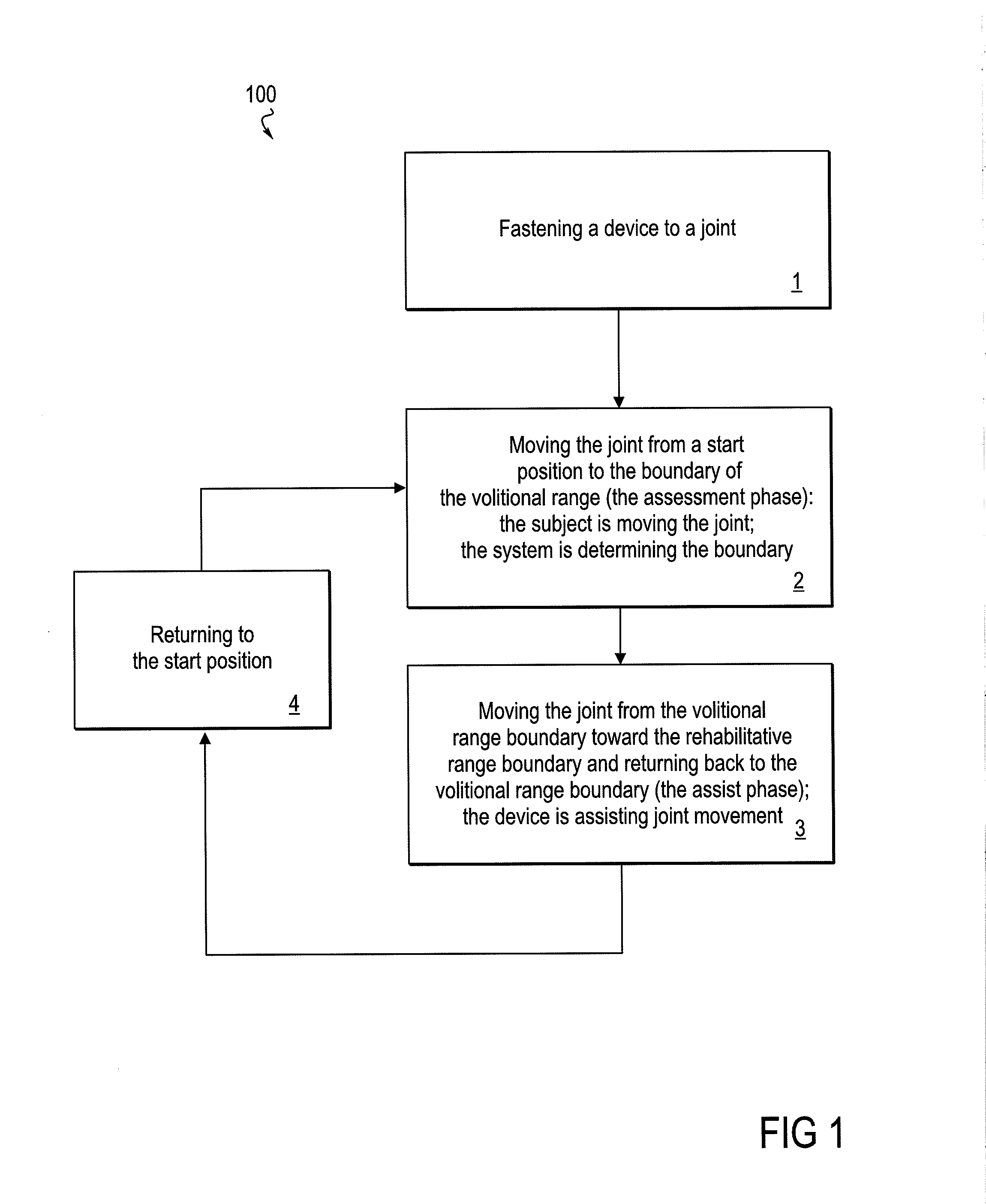Therapeutic method and device for rehabilitation
a therapy method and rehabilitation technology, applied in the field of functional rehabilitation, can solve the problems of not providing joint support or muscle support or augmentation, little if any direct benefit to mobility, and generally not providing rehabilitation or the development of unassisted mobility
- Summary
- Abstract
- Description
- Claims
- Application Information
AI Technical Summary
Benefits of technology
Problems solved by technology
Method used
Image
Examples
embodiment 100
[0049]Various embodiments of the rehabilitative method of the invention are shown in the flow diagram of FIGS. 1-5. FIG. 1 depicts an embodiment 100 of the method in its most basic form. In Step 1, a powered device, or more specifically, an orthotic portion of a powered device, is fastened or applied to sites on either side of a patient's joint. In some embodiments, the method may be applied to more than one joint, in which case, fastening refers to applying an orthotic portion of a powered device at each of the respective joints. Described in the system description section below, for example, are orthotic devices that may be applied to the ankle alone, knee alone, or the combination of the ankle and knee. At the outset of a Step 2, the patient's joint is in a starting position, and the powered device is in a free movement mode that provides substantially no assistance or resistance to movement of the joint. During the Step 2, the patient volitionally moves the joint to the boundary...
embodiment 300
[0055]FIG. 3 depicts Step 3 of an embodiment 300 of the method as depicted in FIG. 1 in more detail. After completion of Steps 1 and 2, in Step 3a, the patient moves the joint to the volitional boundary. In Step 3b, the powered device assists in the movement of the joint from the boundary of volitional movement to the boundary of the extended range of motion or rehabilitative movement. This extended range of motion boundary is a controlled and predetermined boundary that may be set by various formulas or algorithms, or, for example, by the judgment of a medical professional, overseeing the therapy, or by a patient that is sufficiently informed and trained in the method. Step 3c is initiated after the limb has attained the extended range boundary, and the joint is returned with assistance back to the volitional boundary and then volitionally back to the starting point. Some embodiments may provide the return back to the starting position from the volitional boundary as an assisted mo...
embodiment 500
[0059]FIG. 5 shows another embodiment 500 of the method that expands upon the “waiting” feature of the method embodiment shown in FIG. 4, as described above. In this embodiment of the method, the volitional range of motion is continuously re-evaluated during iterations or cycles of the assist phase (Step 3 of FIG. 1) of joint movement, and the volitional range or boundary may be modified during this assist phase, rather than requiring a return to the assessment of volitional range per Step 2 of the method. This embodiment of Step 3 includes an ongoing testing, heuristic, or trial-and-error-based tuning aspect of the method that is based on the performance of the subject with regard to volitional joint movement. This testing may occur within the method in addition to the initial assessment phase that underlies the establishment of a baseline volitional boundary, i.e., the assessment phase (Step 2) as seen in FIG. 1.
[0060]As provided by this embodiment (FIG. 5), the assist phase (Step...
PUM
 Login to View More
Login to View More Abstract
Description
Claims
Application Information
 Login to View More
Login to View More - R&D
- Intellectual Property
- Life Sciences
- Materials
- Tech Scout
- Unparalleled Data Quality
- Higher Quality Content
- 60% Fewer Hallucinations
Browse by: Latest US Patents, China's latest patents, Technical Efficacy Thesaurus, Application Domain, Technology Topic, Popular Technical Reports.
© 2025 PatSnap. All rights reserved.Legal|Privacy policy|Modern Slavery Act Transparency Statement|Sitemap|About US| Contact US: help@patsnap.com



